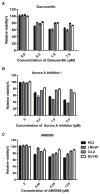AURKA suppression induces DU145 apoptosis and sensitizes DU145 to docetaxel treatment
- PMID: 23634246
- PMCID: PMC3633978
AURKA suppression induces DU145 apoptosis and sensitizes DU145 to docetaxel treatment
Abstract
The palliative therapy effect by docetaxel for CRPC patients makes it urgent to improve the therapy. It was suggested that PI3K and androgen receptor-directed combination therapy may be effective for prostate cancer (PCa) patients PTEN negative. However, for those patients PTEN positive, the mechanism of anti-apoptosis survival of cancer cells is not yet well defined. Amplification of AURKA has been detected in 5% of PCa. In this work, Du145, a PTEN positive PCa cell model, was employed to investigate the role of aurora kinase a (AURKA) on cell growth. Inhibition of AURKA expression by shRNA markedly reduced prostate cancer cell viability. Furthermore, we demonstrate that AURKA inhibition induced a remarkable downregulation of AKT activity and Bax induction. Moreover, specific inhibition of the activity of AURKA, but not other aurora family members, by small molecular chemical inhibitors induced significant cell killing effects. Notably, AURKA inhibition sensitized prostate cancer cells to docetaxel treatment. Our work suggests that AURKA-directed monotherapy or combination therapy with docetaxel could be a potent treatment for PCa patients in future.
Keywords: AURKA; Prostate cancer; aurora kinases; castration-resistant prostate cancer; docetaxel; p53.
Figures




Similar articles
-
The expression of AURKA is androgen regulated in castration-resistant prostate cancer.Sci Rep. 2017 Dec 21;7(1):17978. doi: 10.1038/s41598-017-18210-3. Sci Rep. 2017. PMID: 29269934 Free PMC article.
-
Synergistic anticancer efficacy of MEK inhibition and dual PI3K/mTOR inhibition in castration-resistant prostate cancer.Prostate. 2015 Nov;75(15):1747-59. doi: 10.1002/pros.23057. Epub 2015 Aug 7. Prostate. 2015. PMID: 26250606
-
Aurora Kinase A-YBX1 Synergy Fuels Aggressive Oncogenic Phenotypes and Chemoresistance in Castration-Resistant Prostate Cancer.Cancers (Basel). 2020 Mar 12;12(3):660. doi: 10.3390/cancers12030660. Cancers (Basel). 2020. PMID: 32178290 Free PMC article.
-
The Upregulation of PI3K/Akt and MAP Kinase Pathways is Associated with Resistance of Microtubule-Targeting Drugs in Prostate Cancer.J Cell Biochem. 2015 Jul;116(7):1341-9. doi: 10.1002/jcb.25091. J Cell Biochem. 2015. PMID: 25640606
-
Inhibition of mitotic Aurora kinase A by alisertib induces apoptosis and autophagy of human gastric cancer AGS and NCI-N78 cells.Drug Des Devel Ther. 2015 Jan 14;9:487-508. doi: 10.2147/DDDT.S74127. eCollection 2015. Drug Des Devel Ther. 2015. PMID: 25609923 Free PMC article.
Cited by
-
Inhibitory Effect of Synthetic Flavone Derivatives on Pan-Aurora Kinases: Induction of G2/M Cell-Cycle Arrest and Apoptosis in HCT116 Human Colon Cancer Cells.Int J Mol Sci. 2018 Dec 17;19(12):4086. doi: 10.3390/ijms19124086. Int J Mol Sci. 2018. PMID: 30562979 Free PMC article.
-
Gene Expression Analysis Reveals Key Genes and Signalings Associated with the Prognosis of Prostate Cancer.Comput Math Methods Med. 2021 Aug 28;2021:9946015. doi: 10.1155/2021/9946015. eCollection 2021. Comput Math Methods Med. 2021. PMID: 34497666 Free PMC article.
-
Evaluation of the medicinal herb Graptopetalum paraguayense as a treatment for liver cancer.PLoS One. 2015 Apr 7;10(4):e0121298. doi: 10.1371/journal.pone.0121298. eCollection 2015. PLoS One. 2015. PMID: 25849560 Free PMC article.
-
KAT5 and KAT6B are in positive regulation on cell proliferation of prostate cancer through PI3K-AKT signaling.Int J Clin Exp Pathol. 2013 Nov 15;6(12):2864-71. eCollection 2013. Int J Clin Exp Pathol. 2013. PMID: 24294372 Free PMC article.
-
Ran signaling in melanoma: implications for the development of alternative therapeutic strategies.Cancer Lett. 2015 Feb 1;357(1):286-296. doi: 10.1016/j.canlet.2014.11.033. Epub 2014 Nov 20. Cancer Lett. 2015. PMID: 25444926 Free PMC article.
References
-
- Rini BI, Small EJ. Hormone-refractory Prostate Cancer. Curr Treat Options Oncol. 2002;3:437–446. - PubMed
-
- Singh P, Yam M, Russell PJ, Khatri A. Molecular and traditional chemotherapy: a united front against prostate cancer. Cancer Lett. 2010;293:1–14. - PubMed
-
- Petrylak DP, Tangen CM, Hussain MH, Lara PN Jr, Jones JA, Taplin ME, Burch PA, Berry D, Moinpour C, Kohli M, Benson MC, Small EJ, Raghavan D, Crawford ED. Docetaxel and estramustine compared with mitoxantrone and prednisone for advanced refractory prostate cancer. N Engl J Med. 2004;351:1513–1520. - PubMed
LinkOut - more resources
Full Text Sources
Research Materials
Miscellaneous
